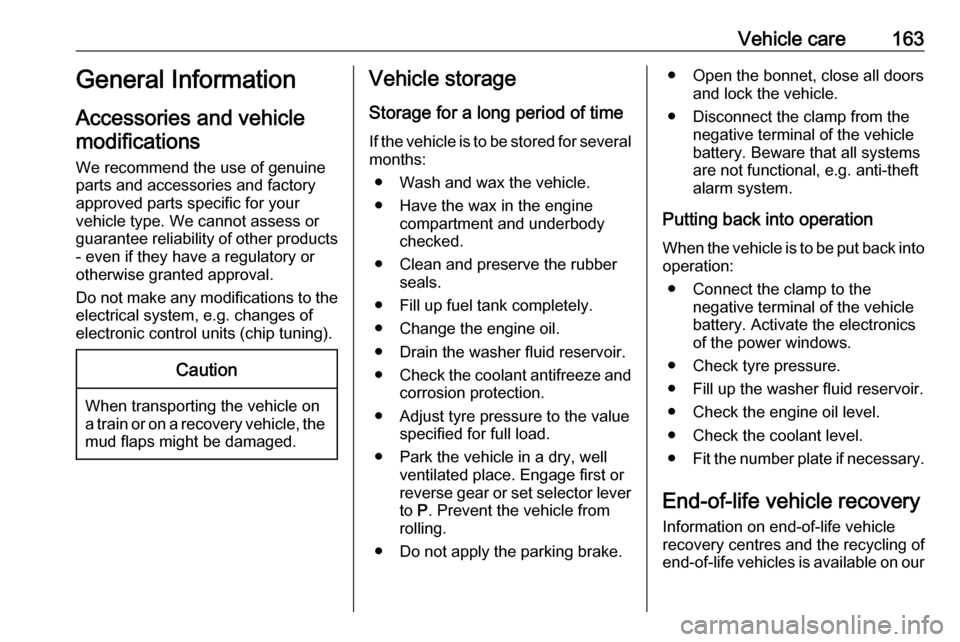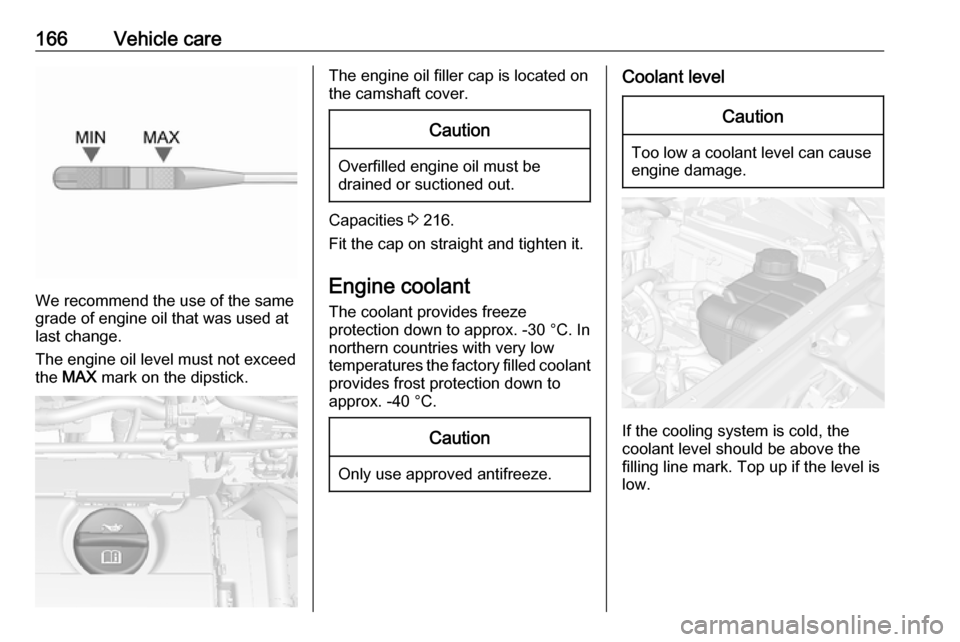engine coolant VAUXHALL MOKKA 2016.5 Owner's Manual
[x] Cancel search | Manufacturer: VAUXHALL, Model Year: 2016.5, Model line: MOKKA, Model: VAUXHALL MOKKA 2016.5Pages: 231, PDF Size: 6.57 MB
Page 72 of 231

70Instruments and controlsInstruments and
controlsControls ....................................... 71
Steering wheel adjustment ........71
Steering wheel controls .............71
Heated steering wheel ...............71
Horn ........................................... 72
Windscreen wiper/washer .........72
Rear window wiper/washer .......74
Outside temperature ..................74
Clock ......................................... 75
Power outlets ............................. 76
Warning lights, gauges and indi‐ cators ........................................... 77
Speedometer ............................. 77
Odometer .................................. 77
Trip odometer ............................ 77
Tachometer ............................... 78
Fuel gauge ................................ 78
Fuel selector .............................. 78
Engine coolant temperature gauge ....................................... 79
Service display .......................... 79
Control indicators ......................80
Turn signal ................................. 83
Seat belt reminder .....................83Airbag and belt tensioners .........83
Airbag deactivation ....................83
Charging system .......................84
Malfunction indicator light ..........84
Service vehicle soon .................84
Brake and clutch system ...........84
Operate pedal ............................ 84
Antilock brake system (ABS) .....84
Upshift ....................................... 85
Descent control system .............85
Power steering .......................... 85
Lane departure warning ............85
Ultrasonic parking assist ...........85
Electronic Stability Control off ...85
Electronic Stability Control and Traction Control system ...........86
Traction Control system off .......86
Preheating ................................. 86
Diesel particle filter ....................86
Tyre pressure monitoring system ...................................... 86
Engine oil pressure ....................86
Low fuel ..................................... 87
Immobiliser ................................ 87
Exterior light .............................. 87
High beam ................................. 87
Adaptive forward lighting ...........87
Fog light ..................................... 88
Rear fog light ............................. 88
Cruise control ............................ 88Vehicle detected ahead .............88
Bonnet open .............................. 88
Door open .................................. 88
Information displays .....................88
Driver Information Centre ..........88
Graphic-Info-Display, Colour- Info-Display .............................. 92
Vehicle messages ........................93
Warning chimes .........................95
Battery voltage .......................... 95
Trip computer ............................... 96
Vehicle personalisation ................99
OnStar ....................................... 102
Page 81 of 231

Instruments and controls79LED off:petrol operationLED
flashes:checking conditions for
fuel transition to liquid
gas operation.
Illuminates if conditions
are fulfilled.LED illu‐
minates:liquid gas operationLED
flashes
five
times
and
extin‐
guishes:liquid gas tank is empty
or failure in liquid gas
system. A message is
displayed in the Driver
Information Centre.
As soon as the liquid gas tank is
empty, petrol operation is
automatically engaged until the
ignition is switched off.
Fuel for liquid gas operation 3 152.
Engine coolant temperature
gauge
Displays the coolant temperature.
left area:engine operating
temperature not yet
reachedcentral
area:normal operating
temperatureright area:temperature too highCaution
If engine coolant temperature is
too high, stop vehicle, switch off
engine. Danger to engine. Check
coolant level.
Service display
The engine oil life system lets you
know when to change the engine oil
and filter. Based on driving
conditions, the interval at which an
engine oil and filter change will be
indicated can vary considerably.
Page 129 of 231

Driving and operating127The engine will be switched off whilethe ignition stays on.
An Autostop is indicated by the
needle at the AUTOSTOP position in
the tachometer.
During an Autostop, the heating
performance, power steering and
brake performance will be
maintained.
Conditions for an Autostop
The stop-start system checks if each
of the following conditions is fulfilled:
● The stop-start system is not manually deactivated.
● The bonnet is fully closed.
● The driver's door is closed or the driver's seat belt is fastened.
● The vehicle battery is sufficiently charged and in good condition.
● The engine is warmed up.
● The engine coolant temperature is not too high.
● The engine exhaust temperature is not too high, e.g. after driving
with high engine load.
● The ambient temperature is above -5 °C.
● The climate control system allows an Autostop.
● The brake vacuum is sufficient.
● The self-cleaning function of the diesel particle filter is not active.
● The vehicle was driven at least at
walking speed since the last
Autostop.
Otherwise an Autostop will be
inhibited.
Certain settings of the climate control
system may inhibit an Autostop. See
Climate control chapter for more
details 3 117.Immediately after motorway driving
an Autostop may be inhibited.
New vehicle running-in 3 124.
Vehicle battery discharge protection
To ensure reliable engine restarts, several battery discharge protection
features are implemented as part of
the stop-start system.
Power saving measures
During an Autostop, several electrical
features such as auxiliary electric
heater or rear window heating are
disabled or switched into a power
saving mode. The fan speed of the
climate control system is reduced to
save power.
Restart of the engine by the driver Depress the clutch pedal to restart the
engine.
The engine start is indicated by the
needle at the idle speed position in
the tachometer.
Page 154 of 231

152Driving and operatingDo not use marine diesel oils, heating
oils, Aquazole and similar diesel-
water emulsions. Diesel fuels must
not be diluted with fuels for petrol
engines.
Fuel for liquid gas operation Liquid gas is known as LPG
(Liquefied Petroleum Gas) or under
its French name GPL (Gaz de Pétrole
Liquéfié). LPG is also known as
Autogas.
LPG consists mainly of propane and butane. The octane rating is between 105 and 115, depending on the
butane proportion. LPG is stored as a
liquid at a pressure of approx. five to
ten bar.
The boiling point depends on the
pressure and the mixing ratio. At
ambient pressure, it is between
-42 °C (pure propane) and -0.5 °C
(pure butane).Caution
The system works at an ambient
temperature of approx. -8 °C to
100 °C.
Full functioning of the LPG system can only be guaranteed with liquid
gas which complies with the minimum
requirements of DIN EN 589.
Fuel selector
Pressing LPG switches between
petrol and liquid gas operation as
soon as the required parameters (coolant temperature, gas
temperature and minimum engine
speed) have been reached. The
requirements are usually fulfilled after
approx. 60 seconds (depending on
exterior temperature) and the first firm press on the accelerator. The status
LED shows the current operating
mode.LED off:petrol operationLED
flashes:checking conditions for
fuel transition to liquid
gas operation.
Illuminates if conditions
are fulfilled.LED illu‐
minates:liquid gas operationLED
flashes
five
times
and
extin‐
guishes:liquid gas tank is empty
or failure in liquid gas
system. A message is
displayed in the Driver
Information Centre.
If the fuel tank is empty, the engine
will not start.
The selected fuel mode is stored and reactivated at the next ignition cycle if
conditions allow.
Page 164 of 231

162Vehicle careVehicle careGeneral Information...................163
Accessories and vehicle modifications .......................... 163
Vehicle storage ........................163
End-of-life vehicle recovery .....163
Vehicle checks ........................... 164
Performing work ......................164
Bonnet ..................................... 164
Engine oil ................................. 165
Engine coolant ......................... 166
Power steering fluid .................167
Washer fluid ............................ 167
Brakes ..................................... 168
Brake fluid ............................... 168
Vehicle battery ......................... 168
Diesel fuel system bleeding .....170
Wiper blade replacement ........170
Bulb replacement .......................171
Halogen headlights ..................171
Xenon headlights .....................173
Fog lights ................................. 174
Front turn signal lights .............174
Tail lights ................................. 175
Side turn signal lights ..............176Centre high-mounted brake
light ......................................... 176
Number plate light ...................177
Interior lights ............................ 177
Electrical system ........................178
Fuses ....................................... 178
Engine compartment fuse box . 178
Instrument panel fuse box .......180
Load compartment fuse box ....181
Vehicle tools .............................. 183
Tools ........................................ 183
Wheels and tyres .......................183
Winter tyres ............................. 183
Tyre designations ....................184
Tyre pressure .......................... 184
Tyre pressure monitoring system .................................... 185
Tread depth ............................. 188
Changing tyre and wheel size . 189 Wheel covers ........................... 189
Tyre chains .............................. 189
Tyre repair kit .......................... 190
Wheel changing .......................193
Spare wheel ............................ 195
Jump starting ............................. 197
Towing ....................................... 199
Towing the vehicle ...................199
Towing another vehicle ...........200Appearance care .......................201
Exterior care ............................ 201
Interior care ............................. 203
Page 165 of 231

Vehicle care163General Information
Accessories and vehicle modifications
We recommend the use of genuine
parts and accessories and factory
approved parts specific for your
vehicle type. We cannot assess or guarantee reliability of other products
- even if they have a regulatory or
otherwise granted approval.
Do not make any modifications to the
electrical system, e.g. changes of
electronic control units (chip tuning).Caution
When transporting the vehicle on
a train or on a recovery vehicle, the
mud flaps might be damaged.
Vehicle storage
Storage for a long period of time
If the vehicle is to be stored for several months:
● Wash and wax the vehicle.
● Have the wax in the engine compartment and underbody
checked.
● Clean and preserve the rubber seals.
● Fill up fuel tank completely.
● Change the engine oil.
● Drain the washer fluid reservoir.
● Check the coolant antifreeze and
corrosion protection.
● Adjust tyre pressure to the value specified for full load.
● Park the vehicle in a dry, well ventilated place. Engage first or
reverse gear or set selector lever
to P. Prevent the vehicle from
rolling.
● Do not apply the parking brake.● Open the bonnet, close all doors and lock the vehicle.
● Disconnect the clamp from the negative terminal of the vehicle
battery. Beware that all systems
are not functional, e.g. anti-theft
alarm system.
Putting back into operation
When the vehicle is to be put back into
operation:
● Connect the clamp to the negative terminal of the vehicle
battery. Activate the electronics
of the power windows.
● Check tyre pressure.
● Fill up the washer fluid reservoir.
● Check the engine oil level.
● Check the coolant level.
● Fit the number plate if necessary.
End-of-life vehicle recovery
Information on end-of-life vehicle
recovery centres and the recycling of
end-of-life vehicles is available on our
Page 168 of 231

166Vehicle care
We recommend the use of the same
grade of engine oil that was used at
last change.
The engine oil level must not exceed
the MAX mark on the dipstick.
The engine oil filler cap is located on
the camshaft cover.Caution
Overfilled engine oil must be
drained or suctioned out.
Capacities 3 216.
Fit the cap on straight and tighten it.
Engine coolant The coolant provides freeze
protection down to approx. -30 °C. In
northern countries with very low
temperatures the factory filled coolant
provides frost protection down to
approx. -40 °C.
Caution
Only use approved antifreeze.
Coolant levelCaution
Too low a coolant level can cause engine damage.
If the cooling system is cold, the
coolant level should be above the
filling line mark. Top up if the level is
low.
Page 169 of 231

Vehicle care1679Warning
Allow the engine to cool before
opening the cap. Carefully open
the cap, relieving the pressure
slowly.
To top up use a 1:1 mixture of
released coolant concentrate mixed
with clean tap water. If no coolant
concentrate is available, use clean
tap water. Install the cap tightly. Have
the coolant concentration checked
and have the cause of the coolant
loss remedied by a workshop.
Power steering fluid
Caution
Extremely small amounts of
contamination can cause steering
system damage and cause it to not work properly. Do not allow
contaminates to contact the fluid
side of the reservoir cap/dipstick or
from entering the reservoir.
Power steering fluid level normally
does not need to be checked. If an
unusual noise sounds during steering or the power steering reacts
conspicuously, seek the assistance of
a workshop.
Washer fluid
Fill with clean water mixed with a
suitable quantity of approved
windscreen washer fluid which
contains antifreeze.
Caution
Only washer fluid with a sufficient
antifreeze concentration provides
protection at low temperatures or
a sudden drop in temperature.
Page 208 of 231

206Service and maintenanceAdditional engine oil additives
The use of additional engine oil
additives could cause damage and
invalidate the warranty.
Engine oil viscosity grades
The SAE viscosity grade gives
information of the thickness of the oil.
Multigrade oil is indicated by two
figures, e.g. SAE 5W-30. The first
figure, followed by a W, indicates the
low temperature viscosity and the
second figure the high temperature viscosity.
Select the appropriate viscosity grade
depending on the minimum ambient
temperature 3 209.
All of the recommended viscosity
grades are suitable for high ambient
temperatures.
Coolant and antifreeze
Use only organic acid type-long life
coolant (LLC) antifreeze approved for
the vehicle. Consult a workshop.
The system is factory filled with
coolant designed for excellent
corrosion protection and frost
protection down to approx. -28 °C. Innorthern countries with very low
temperatures the factory filled coolant provides frost protection down to
approx. -37 °C. This concentration
should be maintained all year round.
The use of additional coolant
additives that intend to give additional
corrosion protection or seal against
minor leaks can cause function
problems. Liability for consequences
resulting from the use of additional coolant additives will be rejected.
Brake and clutch fluidOver time, brake fluid absorbs
moisture which will reduce braking
effectiveness. The brake fluid should therefore be replaced at the specified
interval.
Page 227 of 231

225Control of the vehicle .................124
Controls ........................................ 71
Convex shape .............................. 27
Coolant and antifreeze ...............205
Cruise control ...................... 88, 139
Cupholders .................................. 55
Curtain airbag system .................. 46
D Danger, Warnings and Cautions ...4
Daytime running lights ...............109
Declaration of conformity ............219
Delayed locking ............................ 23
Descent control system .......85, 138
Diesel fuel system bleeding .......170
Diesel particle filter ...............86, 129
Door open .................................... 88
Doors ............................................ 24
Driver assistance systems ..........139
Driver Information Centre .............88
Driving characteristics and towing tips .............................. 158
Driving hints ................................ 124
E Electric adjustment ......................27
Electrical system......................... 178
Electronic climate control system 118
Electronic driving programmes ..132
Electronic Stability Control.......... 137Electronic Stability Control and Traction Control system ............86
Electronic Stability Control off....... 85 End-of-life vehicle recovery .......163
Engine compartment fuse box ...178
Engine coolant ........................... 166
Engine coolant temperature gauge ....................................... 79
Engine data ............................... 212
Engine exhaust .......................... 129
Engine identification ...................208
Engine oil ................... 165, 205, 209
Engine oil pressure ......................86
Entry lighting .............................. 114
Event data recorders ..................223
Exit lighting ................................ 115
Exterior care .............................. 201
Exterior light ................................. 87
Exterior lighting ....................12, 106
Exterior mirrors ............................. 27
F Fault ........................................... 132
First aid kit ................................... 68
Fixed air vents ........................... 121
Flex-Fix system ............................ 56
Fog light ....................................... 88
Fog lights ................................... 174
Folding mirrors ............................. 27
Forward collision alert................. 141Front airbag system .....................45
Front fog lights ........................... 112
Front seats.................................... 35
Front turn signal lights ...............174
Fuel............................................. 151
Fuel consumption - CO 2-
Emissions ............................... 157
Fuel for diesel engines ..............151
Fuel for liquid gas operation .......152
Fuel for petrol engines ...............151
Fuel gauge ................................... 78
Fuel selector ................................ 78
Fuses ......................................... 178
G Gauges ......................................... 77
General information ...................158
Glovebox ..................................... 55
Glove box lighting .......................114
Graphic-Info-Display, Colour- Info-Display .............................. 92
H
Halogen headlights ....................171
Hand brake ................................. 135
Hazard warning flashers ............111
Headlight flash ........................... 108
Headlight range adjustment ......108
Headlights when driving abroad 108
Head restraint adjustment .............8
Head restraints ............................ 34